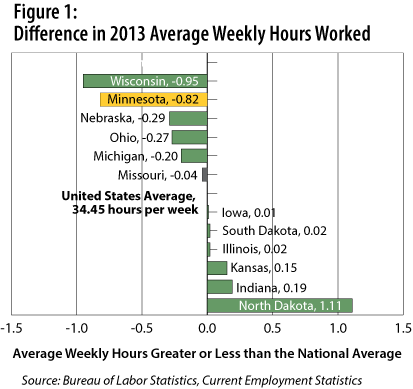by Nick Dobbins
March 2014
Previously we’ve explored various statistics that demonstrate the relative good health of Minnesota’s labor market. By some of the most important measurements we have, from average wages to educational attainment to gross state product, we’re out-performing the national average and neighboring states, often by healthy margins. For instance, our seasonally adjusted unemployment rate, perhaps the most widely-used labor market measure, currently stands at 4.7 percent, 1.9 percent lower than the national average.1 But no one piece of data tells the whole story, and there are indicators of economic health by which we’re struggling. For instance, every month the U.S. Department of Labor produces an estimate for Average Weekly Hours (AWH). AWH is a measure of the average hours per private sector job per week for which pay is received. Government employment is excluded for reasons related to collection difficulty. Seemingly undercutting our strong unemployment rate, Minnesota has an AWH that has been running consistently below the national average since before the recent recession.
In Figure 1 you’ll see that our state AWH of 33.6 is dramatically lower than all but one other state in the Midwest census region and 0.82 hours a week lower than the national average. That may seem like a small difference, but when you consider that the time is multiplied over every job being worked in Minnesota (more than 2.7 million on average in 2013), you see that we’re collectively working over two million hours less per week than we would be if we were at the national AWH level.

You may look at Minnesota’s AWH and begin to think that our low unemployment rate and seemingly healthy economy is a mirage. After all, what good is lower unemployment when it includes fewer hours of actual paid work? The balance of data, however, still strongly suggests that our labor market is very strong. In spite of our shorter work weeks, Minnesotans still earn more money than the average American, both per person (by over $3,300 per year)2 and for a week of work ($938 per week in Minnesota versus $922 nationally)3. We’re also more productive than the average state, with a per capita Gross Domestic Product over $4,000 higher than the national average4. So, if our labor market is healthy, why is our AWH so low? One contributing factor could be our high labor force participation rate, 7.3 percent higher than the national average5, which may be caused by a higher number of people holding part-time jobs that they aren’t financially dependent on. It could also be that Minnesotans are simply less likely to spend more time at work than they need to, or that Minnesota employers are less likely to give their workers the additional hours they want. It’s a question worth exploring, although while we do, it also may be worth considering how much one piece of data can say about our labor markets in the first place.
1U.S. Department of Labor, Bureau of Labor Statistics, Local Area Unemployment Statistics, January 2014.
2U.S Department of Commerce, Bureau of Economic Analysis, 2013 State Personal Income.
3U.S. Department of Labor, Bureau of Labor Statistics, Quarterly Census of Employment and Wages, Third Quarter, 2013.
4U.S. Department of Commerce, Bureau of Economic Analysis: GDP by State.
5U.S. Department of Labor, Bureau of Labor Statistics, Local Area Unemployment Statistics, January 2014.